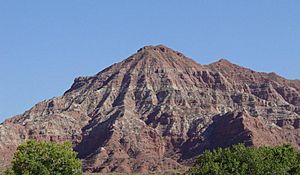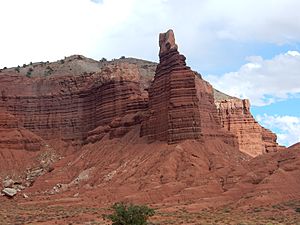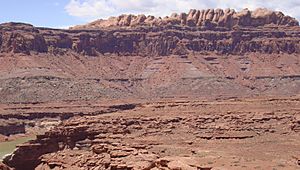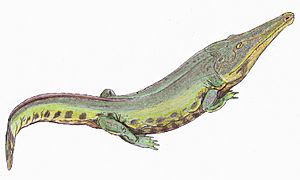Moenkopi Formation facts for kids
Quick facts for kids Moenkopi FormationStratigraphic range: Lower-Middle Triassic |
|
|---|---|

Rock layers of the Moenkopi Formation in Zion National Park
|
|
| Type | Geological formation |
| Sub-units | See "Members" section |
| Underlies | Chinle Formation |
| Overlies | Kaibab Limestone |
| Lithology | |
| Primary | Sandstone |
| Other | Shale |
| Location | |
| Coordinates | 35°55′05″N 111°29′20″W / 35.918°N 111.489°W |
| Region | Northern Arizona Southeast California East-central Nevada Southern Utah Northwestern New Mexico Southwestern Colorado |
| Country | Southwestern United States |
| Type section | |
| Named for | Moenkopi Wash |
| Named by | Ward |
| Year defined | 1901 |
The Moenkopi Formation is a special type of rock layer found across several U.S. states. These states include New Mexico, northern Arizona, Nevada, southeastern California, eastern Utah, and western Colorado. In Arizona, this rock unit is considered a large group of layers.
The Moenkopi Formation is part of the Colorado Plateau and Basin and Range areas. It is mostly made of red sandstone. This rock was formed during the Early Triassic and possibly part of the Middle Triassic periods. This was about 240 million years ago.
Contents
How Geologists Studied the Moenkopi Formation

Scientists have studied the Moenkopi Formation for a long time. It doesn't have one single "type locality," which is a specific place where it was first officially described.
In 1901, a scientist named Ward first named this rock layer. He named it after a place called Moencopie Wash near the Grand Canyon. Later, in 1917, another scientist named Gregory found a "substitute" type locality. This was in the Little Colorado Canyon in Coconino County, Arizona.
Over the years, many other geologists studied the Moenkopi Formation. They found and named different parts of it, called "members." For example, the Sinbad Limestone Member was named in 1928. Scientists also figured out its age more precisely. In 1988, Kietzke used biostratigraphy (studying fossils) to confirm its age as Early and Middle Triassic.
What Does the Moenkopi Formation Look Like?

The Moenkopi Formation is made of thin layers of sandstone, mudstone, and shale. Some areas, like Capitol Reef National Park, also have layers of limestone. It has a special deep red color. These rocks often form gentle slopes and flat areas called benches.
The way these rocks were formed changed from place to place. In the east, they were laid down by rivers flowing across floodplains. In the Cedar Mesa area, they formed in tidal mudflats. In places like Capitol Reef, they were deltaic sandstones and shallow ocean limestones.
The land where the Moenkopi formed was very flat. It was a coastal plain with slow-moving rivers flowing to the sea. Because the land was so flat, the shoreline moved a lot with changes in sea level or even with the tides.
The thickness of the Moenkopi Formation varies greatly. It can be very thin in some places. In southwestern Utah, it can be over 2,000 feet (610 meters) thick.
Rock Layers Above and Below
The Moenkopi Formation sits on top of older rocks from the Paleozoic Era. It is covered by a younger rock layer called the Chinle Formation. There are gaps in time between these layers, which geologists call "unconformities." These gaps mean that some rock layers were eroded away or never deposited.
The gap below the Moenkopi represents at least 20 million years. The gap above it, before the Chinle Formation, represents about 10 million years.
Members of the Moenkopi Formation
The Moenkopi Formation is divided into smaller parts called "members." These members can be different depending on where you are. This is because some sandstone layers, formed by the sea covering the land, are used to define members in the west. These layers cannot be found in the east.
Here are some of the members found in different regions:
Paradox Basin Members
- Tenderfoot Member: This layer is up to 290 feet (88 meters) thick. It has a mix of rocky material, gypsum, and sandy mudstone.
- Ali Baba Member: This member is made of red, rocky sandstone and siltstone. It was formed by strong rivers.
- Sewemup Member: This layer has thin beds of siltstone, shale, and sandstone. It contains enough gypsum to give it a light brown color.
- Parriott Member: This member stands out with its many colors, including brown, red, orange, and purple. It is only found in a few specific locations.
Canyonlands and Glen Canyon Area Members
- Hoskinnini Member: This member is made of sandstone and siltstone. It is found only in the southern part of this area.
- Black Dragon Member: This layer has a rocky base. It also includes thin layers of red sandstone, siltstone, and shale. These were deposited in a tidal flat environment.
- Sinbad Limestone Member: This member is named after the Sinbad region. It is made of yellowish limestone, formed when the sea briefly covered the land.
- Torrey Member: These are red rock layers, showing that the land was above water again.
- Moody Canyon Member: This member has thin layers of siltstone and mudstone that form slopes. It also has small amounts of evaporite minerals.
San Juan Basin and Tucumcari Members
- Anton Chico Member: This member was once thought to be part of another formation. However, scientists later found that it was part of the Moenkopi Formation. It was formed in the same large basin as other Moenkopi rocks in Arizona.
Where Can You See the Moenkopi Formation?

(6)-Rounded tan domes of the Navajo Sandstone, (5)-(dark)-layered red Kayenta Formation, (4)-cliff-forming, vertically-jointed, red Wingate Sandstone, (3)-slope-forming, purplish Chinle Formation, (2)-layered, lighter-red Moenkopi Formation, and (1)-white, layered Cutler Formation sandstone. Picture from Glen Canyon National Recreation Area, Utah.
You can find the Moenkopi Formation in many different geological areas and national parks across the Southwestern United States.
Some of the geological locations include:
- Black Mesa Basin
- Great Basin province
- Paradox Basin
- San Juan Basin
- Uinta Basin
You can also see these rocks in many famous parks, such as:
- Grand Canyon National Park
- Capitol Reef National Park
- Zion National Park
- Monument Valley Navajo Nation Tribal Park
- Glen Canyon National Recreation Area
- Walnut Canyon National Monument
- Wupatki National Monument
Animals Found in the Moenkopi Formation
Many different kinds of ancient animals have been found as fossils in the Moenkopi Formation. Most of these fossils come from the Wupatki and Holbrook Members in northern Arizona.
Some of the early vertebrates (animals with backbones) found include:
- Freshwater hybodont sharks
- Coelacanths (a type of fish)
- Lungfish
Amphibians called temnospondyls are also common. These include creatures like Eocyclotosaurus, Quasicyclotosaurus, and Wellesaurus.
A type of reptile called a rhynchosaur (Ammorhynchus) has been found, but it is rare. Anisodontosaurus is another mysterious reptile known only from a few jaw bones.
A large reptile called Arizonasaurus (a poposauroid archosaur) is known from a nearly complete skeleton. Footprints and some body fossils of dicynodonts (ancient mammal-like reptiles) have also been discovered. Common footprints found include those of Cheirotherium and Rhynchosauroides in the Wupatki Member.
Images for kids
-
Rock layers of the Moenkopi Formation in Zion National Park



